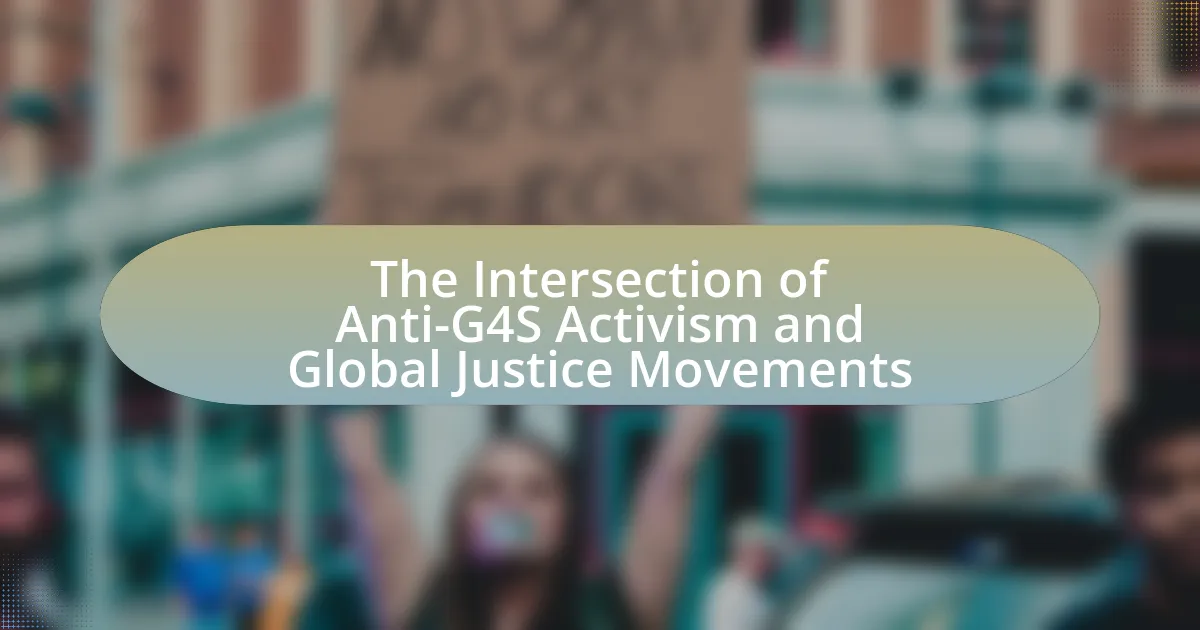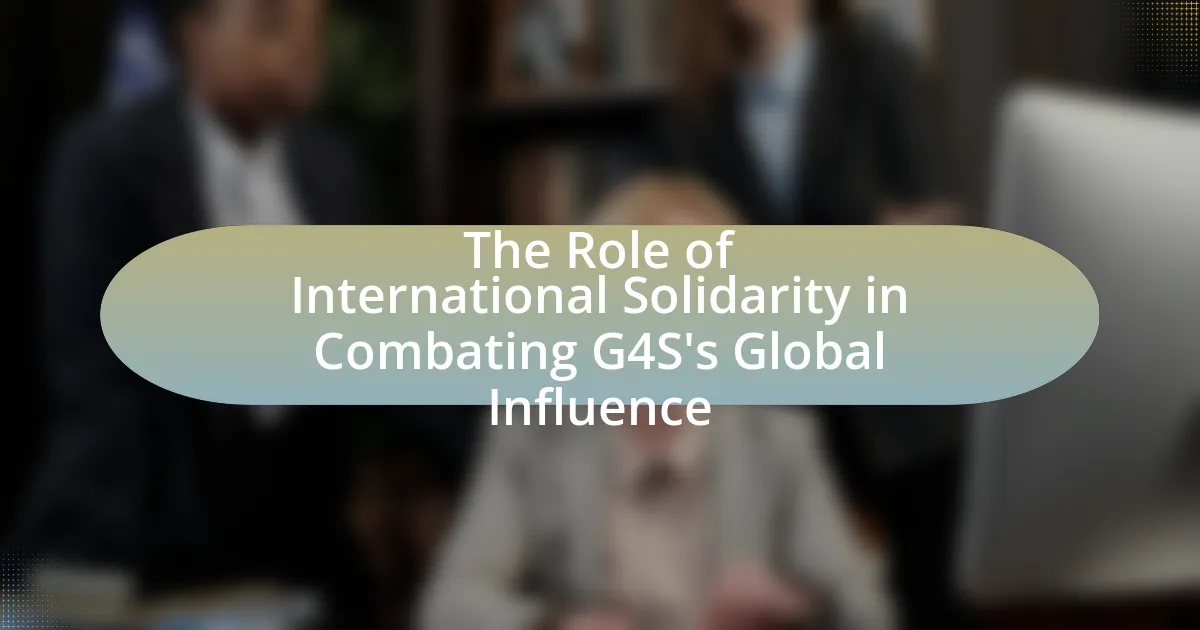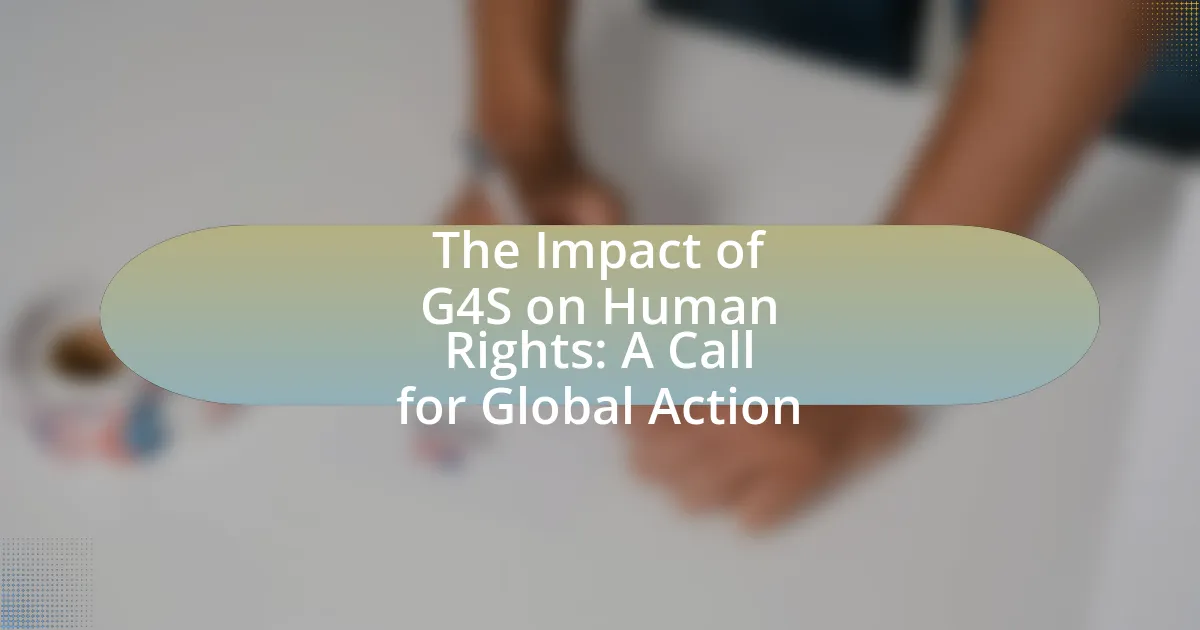Digital activism refers to the use of digital tools and platforms to drive social change and support social movements, playing a vital role in organizing protests and raising awareness on global issues. This article explores how social media has transformed activism by enabling rapid communication and mobilization, exemplified by movements like the Arab Spring and #BlackLivesMatter. It examines the features of social media that facilitate activism, the importance of international solidarity, and the specific focus on G4S, a multinational security company criticized for human rights violations. Additionally, the article discusses the challenges faced by digital activists, effective strategies for mobilization, and the future trends in digital activism against corporations like G4S.
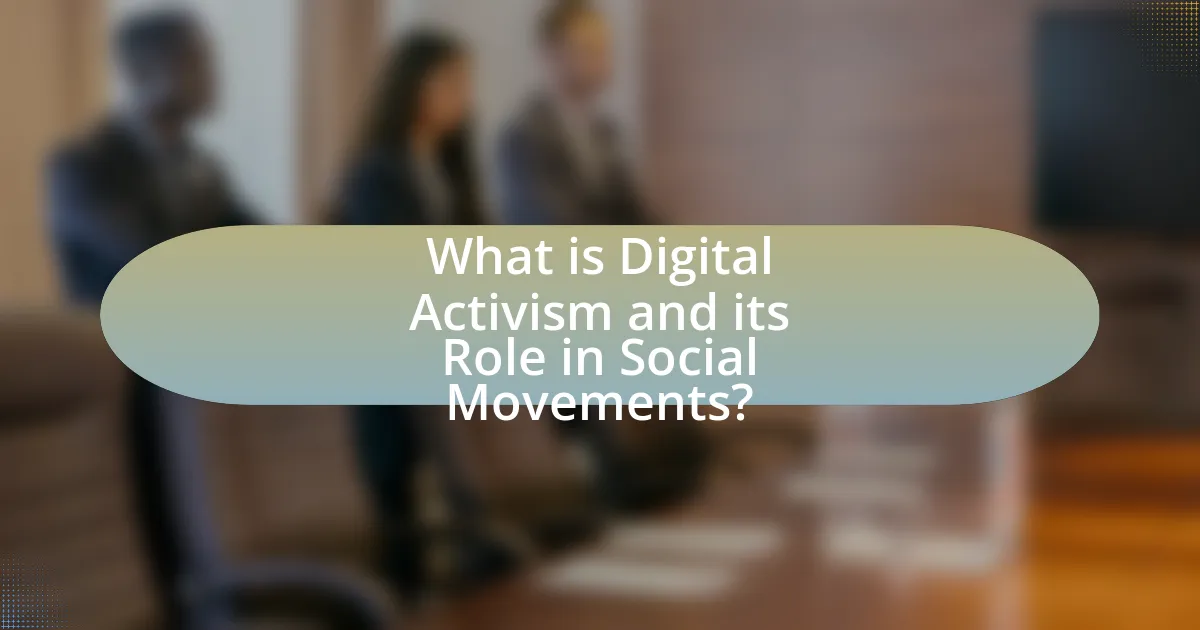
What is Digital Activism and its Role in Social Movements?
Digital activism is the use of digital tools and platforms to promote social change and mobilize support for social movements. It plays a crucial role in social movements by facilitating communication, organizing protests, and raising awareness on issues, often reaching a global audience quickly. For instance, the Arab Spring demonstrated how social media platforms like Twitter and Facebook enabled activists to coordinate protests and share information, leading to significant political changes in several countries. This illustrates that digital activism not only amplifies voices but also enhances the effectiveness of grassroots movements by connecting individuals and organizations across geographical boundaries.
How has social media transformed the landscape of activism?
Social media has transformed the landscape of activism by enabling rapid communication, widespread mobilization, and global reach. Platforms like Twitter, Facebook, and Instagram allow activists to share information instantly, organize events, and connect with supporters across the world. For instance, the Arab Spring in 2011 demonstrated how social media facilitated protests and coordinated actions in multiple countries, leading to significant political changes. Additionally, studies show that social media campaigns can increase participation in movements; for example, the #BlackLivesMatter movement gained traction through viral posts, raising awareness and prompting discussions on racial injustice. This shift has made activism more accessible, allowing diverse voices to contribute to social change.
What are the key features of social media that facilitate activism?
The key features of social media that facilitate activism include rapid information dissemination, community building, and mobilization capabilities. Rapid information dissemination allows activists to share news and updates instantly, reaching a global audience; for instance, during the Arab Spring, social media platforms played a crucial role in spreading information about protests and government responses. Community building enables like-minded individuals to connect, share resources, and support each other, exemplified by the #MeToo movement, which created a global network of individuals sharing their experiences. Mobilization capabilities allow for organizing events and campaigns efficiently, as seen in the global climate strikes, where social media was instrumental in coordinating participation across multiple countries. These features collectively enhance the effectiveness of activism by amplifying voices, fostering solidarity, and facilitating action.
How do different platforms serve various activist needs?
Different platforms serve various activist needs by providing tailored functionalities that enhance outreach, engagement, and mobilization. For instance, Twitter facilitates real-time communication and rapid dissemination of information, making it ideal for urgent calls to action and updates during protests. Facebook allows for community building and event organization, enabling activists to create groups and pages that foster discussion and coordination among supporters. Instagram, with its visual focus, serves to raise awareness through impactful imagery and storytelling, appealing to younger audiences and enhancing emotional connections to causes. Research indicates that 79% of social media users believe these platforms are effective for activism, highlighting their role in amplifying voices and creating solidarity movements, such as those against G4S.
Why is international solidarity important in activism?
International solidarity is crucial in activism because it fosters a unified global response to social injustices, amplifying the voices of marginalized communities. This collective action enhances the effectiveness of campaigns by sharing resources, strategies, and support across borders, which is particularly vital in addressing issues like human rights violations. For instance, the global movement against apartheid in South Africa demonstrated how international solidarity can pressure governments and corporations to change policies. By leveraging social media, activists can mobilize international support quickly, as seen in campaigns like #BlackLivesMatter, which gained worldwide traction and solidarity, highlighting the interconnectedness of struggles against systemic oppression.
What are the historical examples of international solidarity movements?
Historical examples of international solidarity movements include the anti-apartheid movement, which garnered global support against South Africa’s racial segregation policies, particularly through campaigns like the Boycott, Divestment, Sanctions (BDS) movement. Another significant example is the global labor movement, which united workers across borders to advocate for labor rights and fair wages, exemplified by the International Trade Union Confederation. Additionally, the feminist movements of the 1970s and 1980s, such as the Women’s International Democratic Federation, sought to promote women’s rights globally. These movements illustrate how collective action transcended national boundaries, mobilizing support and resources to address social injustices.
How does international solidarity enhance the effectiveness of local movements?
International solidarity enhances the effectiveness of local movements by providing them with broader visibility, resources, and support networks. When local movements receive international attention, they can amplify their messages and attract more participants, as seen in the global response to the Black Lives Matter movement, which gained momentum through international solidarity. This support often includes sharing resources, funding, and strategic advice, which can significantly bolster local efforts. For example, during protests against G4S, international activists utilized social media platforms to raise awareness and mobilize support, demonstrating how interconnected movements can lead to greater impact and effectiveness in achieving their goals.
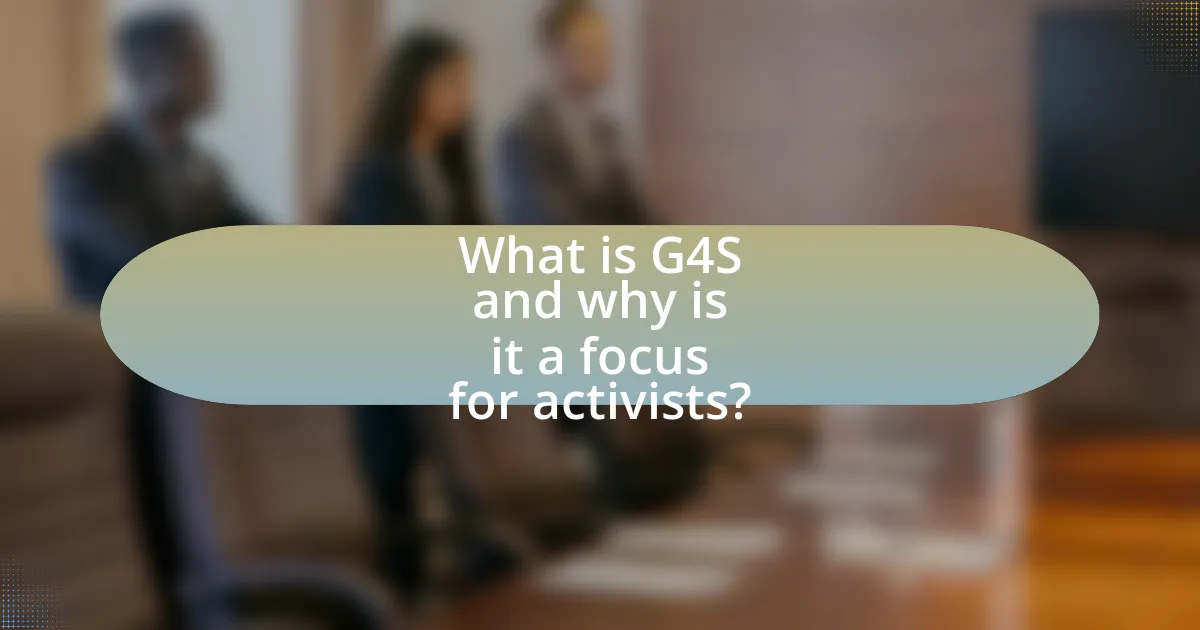
What is G4S and why is it a focus for activists?
G4S is a multinational security company that provides a range of services including security personnel, technology solutions, and cash management. Activists focus on G4S due to its involvement in controversial practices, such as providing security services to prisons and detention centers, including those that detain migrants and refugees. This has led to accusations of human rights violations and complicity in state violence, prompting campaigns for divestment and calls for accountability from the company.
What are the main controversies surrounding G4S?
The main controversies surrounding G4S include allegations of human rights abuses, involvement in the Israeli-Palestinian conflict, and issues related to the treatment of detainees. G4S has faced criticism for its role in operating security services in Israeli settlements, which many view as contributing to the occupation of Palestinian territories. Additionally, reports have emerged regarding the company’s handling of prisoners in various countries, leading to accusations of mistreatment and inadequate conditions. These controversies have sparked significant public outcry and mobilization through digital activism, with various organizations leveraging social media to raise awareness and call for accountability.
How do G4S’s operations impact human rights globally?
G4S’s operations impact human rights globally by engaging in practices that have been linked to human rights violations, including the detention of individuals without due process and the use of excessive force. Reports from organizations such as Amnesty International and Human Rights Watch have documented instances where G4S has provided security services in contexts that undermine human rights, particularly in immigration detention centers and conflict zones. For example, G4S has faced criticism for its role in operating detention facilities in the UK and Australia, where detainees have reported mistreatment and inadequate living conditions. These operations contribute to a broader pattern of systemic human rights abuses, prompting calls for accountability and reform from various human rights advocates and digital activists.
What role does G4S play in the privatization of public services?
G4S plays a significant role in the privatization of public services by providing security and facility management services to governments and private entities. The company has expanded its operations globally, often taking over functions traditionally managed by public sectors, such as prison management, immigration services, and security for public events. For instance, G4S has been involved in managing prisons in the UK and Australia, which illustrates its influence in shifting public services to private management. This trend raises concerns about accountability and the quality of services provided, as evidenced by various reports highlighting issues in facilities managed by G4S, such as overcrowding and inadequate care.
How can digital activism specifically target G4S?
Digital activism can specifically target G4S by leveraging social media platforms to raise awareness about the company’s controversial practices, such as its involvement in the Israeli-Palestinian conflict and its management of immigration detention centers. Campaigns can utilize hashtags, viral content, and coordinated online actions to mobilize public opinion against G4S, as seen in the Boycott, Divestment, Sanctions (BDS) movement, which has successfully pressured companies through social media engagement. Evidence of this effectiveness is reflected in the growing number of organizations and individuals who have publicly called for boycotts, resulting in G4S losing contracts and facing reputational damage.
What strategies have been effective in mobilizing online campaigns against G4S?
Effective strategies for mobilizing online campaigns against G4S include leveraging social media platforms for awareness, creating viral content that highlights human rights abuses, and organizing coordinated hashtag campaigns. Social media platforms like Twitter and Facebook have been instrumental in disseminating information rapidly, allowing activists to reach a global audience. For instance, campaigns such as #StopG4S have successfully raised awareness about G4S’s involvement in controversial practices, leading to increased public scrutiny and pressure on the company. Additionally, the use of petitions and online fundraising has facilitated grassroots support, enabling organizations to sustain their efforts and amplify their messages. These strategies have proven effective in mobilizing international solidarity and fostering a collective response against G4S’s operations.
How can hashtags and viral content amplify the message against G4S?
Hashtags and viral content can significantly amplify the message against G4S by increasing visibility and engagement across social media platforms. When users employ specific hashtags related to G4S, such as #BoycottG4S or #G4SAccountability, these tags create a unified narrative that can reach a broader audience, facilitating discussions and raising awareness about the company’s controversial practices. Viral content, including videos, memes, and infographics, can capture attention quickly and encourage sharing, leading to exponential growth in reach. For instance, campaigns like #BlackLivesMatter have shown how viral content can mobilize support and drive social change, demonstrating that similar strategies can effectively challenge G4S’s actions.
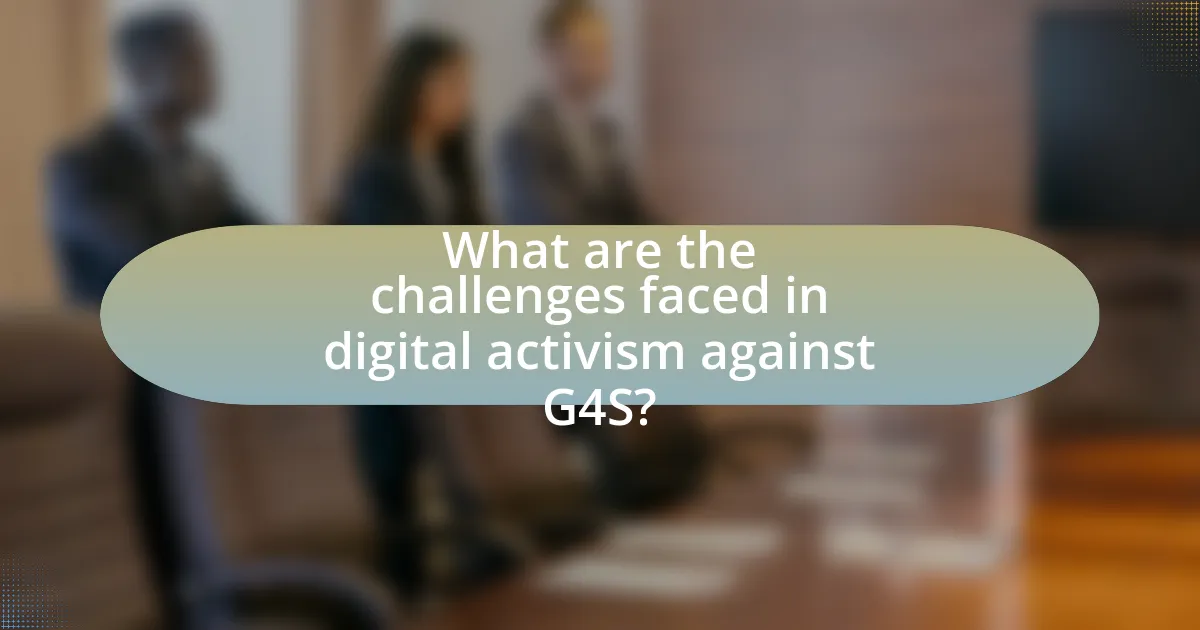
What are the challenges faced in digital activism against G4S?
Digital activism against G4S faces several challenges, including censorship, misinformation, and the company’s extensive resources for countering activism. Censorship occurs when platforms restrict content related to G4S, limiting the reach of activists’ messages. Misinformation can undermine campaigns by spreading false narratives about G4S’s practices or the activists themselves, creating confusion among the public. Additionally, G4S has significant financial and legal resources to combat negative publicity, which can intimidate activists and hinder their efforts. These challenges complicate the ability of digital activists to effectively mobilize support and raise awareness about G4S’s controversial operations.
What obstacles do activists encounter when using social media?
Activists encounter several obstacles when using social media, including censorship, misinformation, and algorithmic bias. Censorship can occur when platforms restrict or remove content that challenges political or corporate interests, limiting activists’ ability to communicate their messages effectively. Misinformation spreads rapidly on social media, making it difficult for activists to counter false narratives and maintain credibility. Additionally, algorithmic bias can suppress the visibility of activist content, as algorithms may prioritize mainstream narratives over marginalized voices, hindering outreach efforts. These challenges can significantly impact the effectiveness of digital activism.
How do censorship and misinformation affect digital activism?
Censorship and misinformation significantly hinder digital activism by obstructing the flow of accurate information and suppressing voices advocating for social change. Censorship limits access to critical data and narratives, which can prevent activists from mobilizing support and sharing their messages effectively. For instance, in countries with strict internet regulations, activists often face barriers that restrict their ability to organize and communicate, leading to diminished public awareness and engagement. Misinformation further complicates this landscape by spreading false narratives that can discredit legitimate movements, confuse potential supporters, and create divisions within activist communities. Research indicates that misinformation campaigns can undermine trust in social movements, as seen during various protests where misleading information circulated widely, impacting public perception and participation. Thus, both censorship and misinformation create substantial challenges for digital activism, ultimately weakening its impact and effectiveness.
What are the risks of online activism for individuals involved?
The risks of online activism for individuals involved include potential legal repercussions, personal safety threats, and psychological impacts. Legal repercussions can arise from engaging in activities deemed illegal by authorities, such as protests or sharing sensitive information, which may lead to arrests or charges. Personal safety threats are significant, as activists may face harassment, doxxing, or physical violence from opposing groups or individuals. Psychological impacts can manifest as stress, anxiety, or burnout due to the emotional toll of activism and online scrutiny. According to a study published in the Journal of Communication, online activists often report feeling vulnerable to backlash, which can deter participation and affect mental health.
How can activists overcome these challenges?
Activists can overcome challenges in digital activism by leveraging strategic communication, building coalitions, and utilizing data analytics. Strategic communication involves crafting clear, compelling messages that resonate with diverse audiences, which can enhance engagement and mobilization. Building coalitions with other organizations amplifies reach and resources, as seen in successful campaigns like the #BlackLivesMatter movement, which united various groups to address systemic racism. Utilizing data analytics helps activists understand audience behavior and optimize outreach efforts, as evidenced by studies showing that targeted social media campaigns can increase participation rates by up to 50%. These approaches collectively empower activists to navigate obstacles effectively and foster international solidarity against entities like G4S.
What best practices can enhance the effectiveness of digital campaigns?
To enhance the effectiveness of digital campaigns, organizations should focus on clear messaging, audience targeting, and data-driven strategies. Clear messaging ensures that the campaign’s goals and values resonate with the audience, making it easier for them to engage and share. Audience targeting allows campaigns to reach specific demographics, increasing relevance and impact; for instance, using analytics tools can identify key segments that are more likely to support the cause. Data-driven strategies, such as A/B testing and performance metrics, provide insights into what works best, allowing for real-time adjustments that optimize engagement and conversion rates. According to a study by HubSpot, campaigns that utilize targeted messaging can see conversion rates increase by up to 202%.
How can activists build resilient online communities for support?
Activists can build resilient online communities for support by fostering inclusive dialogue, establishing clear communication channels, and creating shared resources. Inclusive dialogue encourages diverse participation, which strengthens community bonds and enhances collective problem-solving. Clear communication channels, such as dedicated social media groups or forums, facilitate real-time interaction and information sharing, essential for mobilizing support during critical moments. Additionally, creating shared resources, like toolkits or educational materials, empowers community members with knowledge and skills, reinforcing their commitment and resilience. Research indicates that communities with strong social ties and shared goals are more effective in sustaining activism, as evidenced by the success of various social movements that utilized these strategies to maintain engagement and support over time.

What are the future trends in digital activism against corporations like G4S?
Future trends in digital activism against corporations like G4S include increased use of social media platforms for organizing and mobilizing grassroots campaigns, leveraging data analytics for targeted messaging, and the rise of decentralized networks that enhance collaboration among activists globally. Social media’s role in amplifying voices and creating viral content will continue to be pivotal, as seen in movements like Black Lives Matter, which effectively utilized platforms to challenge corporate practices. Additionally, the integration of blockchain technology may provide transparency in funding and operations, fostering trust among supporters. These trends indicate a shift towards more strategic, data-driven approaches in digital activism, enhancing the effectiveness of campaigns against corporations like G4S.
How is technology evolving to support activist efforts?
Technology is evolving to support activist efforts by enhancing communication, mobilization, and awareness through digital platforms. Social media networks like Twitter and Facebook enable activists to share information rapidly, organize events, and connect with global audiences, amplifying their messages. For instance, the Arab Spring demonstrated how platforms could facilitate grassroots movements, leading to significant political changes. Additionally, tools such as crowdfunding websites and online petitions empower activists to gather resources and support for their causes, exemplified by campaigns like #BlackLivesMatter, which raised millions for social justice initiatives. These advancements illustrate how technology is integral to modern activism, fostering solidarity and collective action across borders.
What role do emerging technologies play in shaping activism?
Emerging technologies play a crucial role in shaping activism by enhancing communication, mobilization, and awareness. These technologies, particularly social media platforms, enable activists to reach a global audience instantly, facilitating the rapid dissemination of information and organizing efforts. For instance, during the Arab Spring, platforms like Twitter and Facebook were instrumental in coordinating protests and sharing real-time updates, demonstrating how technology can amplify grassroots movements. Additionally, data analytics and digital tools allow activists to track social issues and engage supporters effectively, as seen in campaigns against corporations like G4S, where online solidarity has mobilized international attention and action.
How can data analytics improve campaign strategies?
Data analytics can significantly improve campaign strategies by enabling organizations to understand audience behavior and preferences through data-driven insights. By analyzing social media interactions, engagement metrics, and demographic data, campaigns can be tailored to resonate more effectively with target audiences. For instance, a study by the Pew Research Center found that campaigns utilizing data analytics saw a 20% increase in engagement rates compared to those that did not. This demonstrates that leveraging data analytics allows for more precise targeting, optimized messaging, and ultimately, enhanced campaign effectiveness.
What practical steps can individuals take to engage in digital activism?
Individuals can engage in digital activism by utilizing social media platforms to raise awareness and mobilize support for causes. They can create and share informative content, such as articles, videos, and infographics, that highlight issues related to G4S and its impact on human rights. Additionally, individuals can participate in online campaigns by signing petitions, sharing posts, and using relevant hashtags to amplify their message. Engaging in discussions within online communities and collaborating with organizations focused on social justice can further enhance their activism efforts. According to a study by the Pew Research Center, 69% of adults in the U.S. use social media, making it a powerful tool for reaching a wide audience and fostering international solidarity.
How can one effectively use social media to raise awareness about G4S?
To effectively use social media to raise awareness about G4S, individuals and organizations should create targeted campaigns that highlight specific issues related to G4S, such as human rights violations or labor practices. Engaging content, including infographics, videos, and personal stories, can capture attention and encourage sharing. For instance, using statistics from credible sources, like reports from Amnesty International, can substantiate claims about G4S’s practices, making the message more compelling. Additionally, leveraging hashtags and collaborating with influencers can expand reach and foster community engagement, amplifying the awareness efforts.
What resources are available for individuals looking to get involved?
Individuals looking to get involved in digital activism against G4S can access various resources, including online platforms, social media campaigns, and activist organizations. Websites like Change.org and Avaaz.org provide petitions and campaigns that individuals can support or initiate. Social media platforms such as Twitter and Facebook host groups and hashtags dedicated to raising awareness about G4S’s practices, allowing individuals to share information and mobilize support. Additionally, organizations like Amnesty International and Human Rights Watch offer toolkits and guides for effective activism, providing concrete strategies for engagement and advocacy. These resources empower individuals to participate actively in the movement for international solidarity against G4S.



